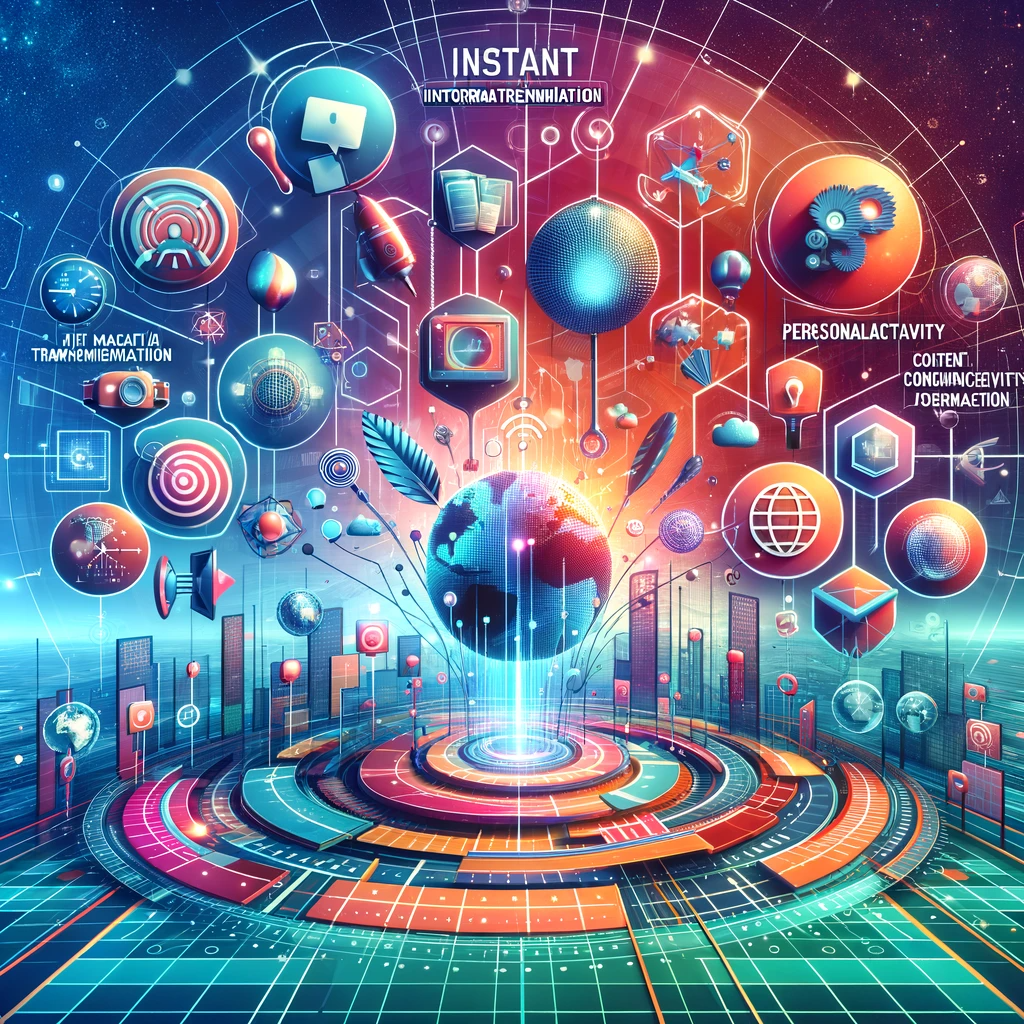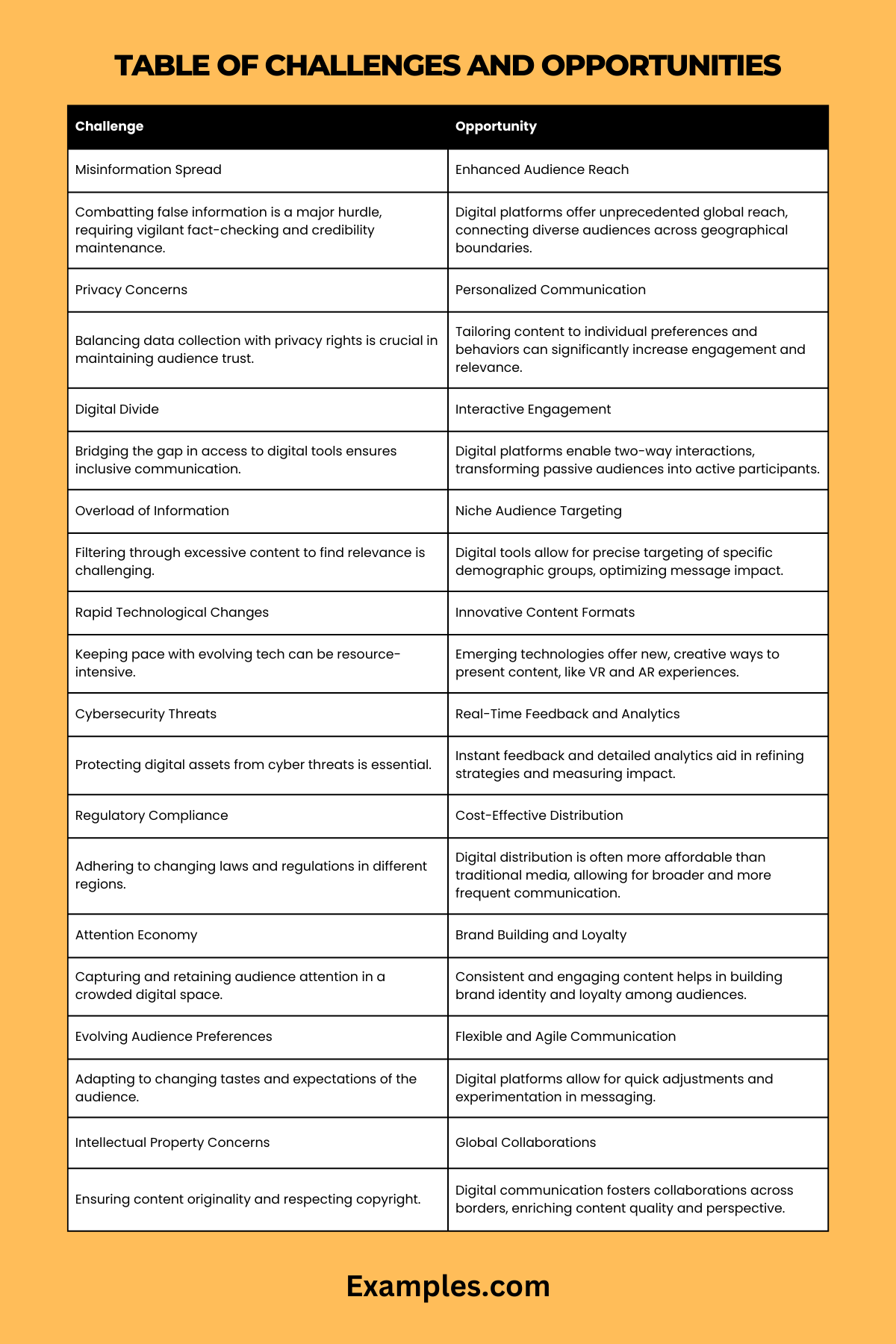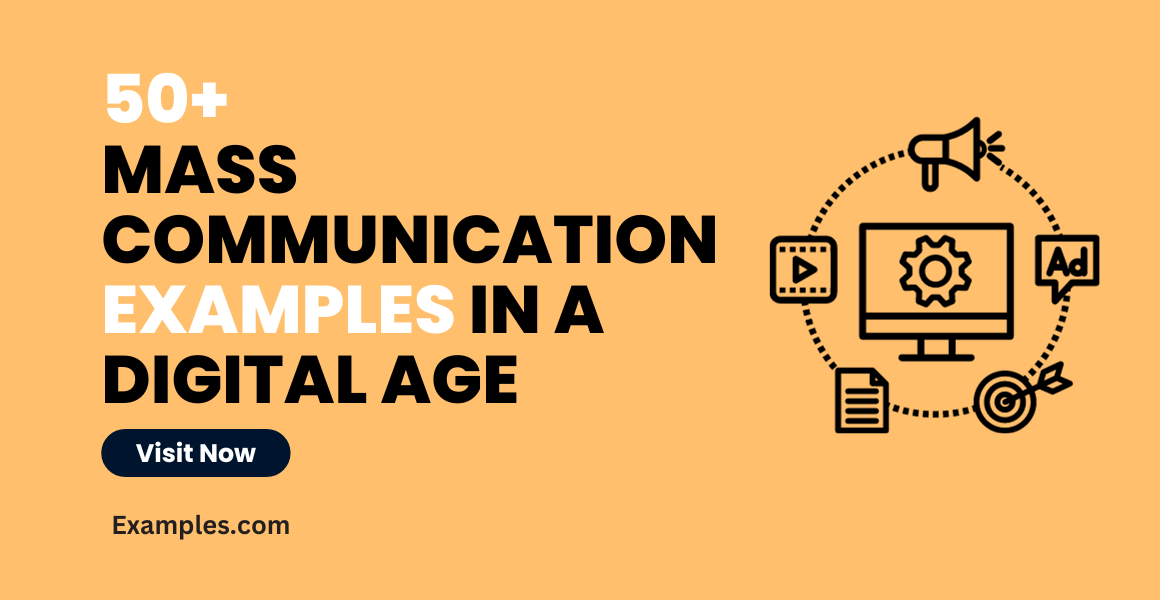49+ Mass Communication Examples in a Digital Age Examples
In the ever-evolving digital landscape, the realm of Mass Communication has undergone significant transformation. This comprehensive guide delves into numerous Mass Communication Examples in a Digital Age, illustrating how technology has reshaped the way we share and consume information. From the power of social media to the influence of digital journalism, each example is accompanied by a sentence explanation, offering practical insights into modern communication strategies. This guide is an essential resource for understanding the diverse and dynamic nature of digital mass communication.
50 Mass Communication Examples in a Digital Age
In today’s digital age, Mass Communication has transformed dramatically, offering new platforms and methods for conveying messages. Our list of 50 Mass Communication Examples showcases the diversity and innovation in this field. These examples span various media types, from traditional broadcasting to cutting-edge digital channels, providing a comprehensive view of how communication is executed and received in the modern world. Each example is not only unique but also comes with a two-line explanation, enhancing understanding and application in real-life scenarios.
- The New York Times uses interactive graphics to simplify complex news stories. This approach makes intricate topics more accessible and engaging for readers, enhancing understanding through visual storytelling.
- Coca-Cola’s ‘Share a Coke’ campaign personalized bottles with names. This ingenious marketing strategy created a personal connection with the consumer, making the brand more relatable and memorable.
- BuzzFeed’s listicle articles on social media trends. These articles capture the essence of current social trends, presented in an easily digestible format that resonates with a wide audience.
- TED Talks’ use of YouTube to disseminate ideas. This platform extends the reach of educational content, making it accessible to a global audience and encouraging knowledge sharing.
- Airbnb’s email newsletters featuring travel stories. These newsletters blend storytelling with marketing, engaging subscribers with compelling content while promoting their services.
- Nike’s interactive advertising campaigns on Instagram. Nike leverages Instagram’s features to create immersive ads that engage users and enhance brand visibility.
- BBC’s podcasts on global issues. These podcasts provide in-depth analysis on current events, making complex global issues more understandable for the listener.
- Spotify’s data-driven personalized playlists. By using listener data, Spotify offers a customized experience, showcasing the power of targeted communication in the digital age.
- National Geographic’s use of Instagram for wildlife awareness. Their captivating visuals and informative captions educate followers about wildlife and conservation efforts.
- Google Doodles celebrating significant events and personalities. These doodles are a creative way to educate and engage users about historical and current events worldwide.
- LinkedIn’s professional networking features. LinkedIn exemplifies how digital platforms can foster career-related communication and networking.
- Facebook Live sessions by influencers. These live interactions create a real-time connection between influencers and their audience, enhancing engagement.
- WhatsApp’s end-to-end encryption feature for secure messaging. This feature highlights the importance of privacy in digital communication.
- TikTok’s short video format for storytelling. TikTok revolutionizes content creation with its brief yet compelling video format, ideal for quick and engaging storytelling.
- Duolingo’s interactive language learning app. This app exemplifies educational communication, making learning a new language fun and accessible.
- Adobe’s creative software tutorials on YouTube. These tutorials demonstrate effective educational communication, helping users master digital creative tools.
- TheSkimm’s daily news summary emails. This service distills complex news into concise, readable summaries, ideal for busy readers.
- Reddit’s AMA (Ask Me Anything) sessions. These sessions foster direct communication between personalities and the public, offering insights into various topics.
- Waze’s user-generated traffic updates. This collaborative approach to navigation highlights community-based communication in the digital era.
- Slack’s workplace communication tools. Slack demonstrates how digital platforms can streamline and enhance workplace communication.
- Uber’s in-app messaging for drivers and riders. This feature illustrates real-time, purpose-driven communication within a service-based app.
- Pinterest’s visual search feature for idea inspiration. This tool exemplifies the use of visual media for communication in the digital age.
- Zoom’s video conferencing capabilities for remote work. Zoom shows how digital tools facilitate effective communication in a virtual work environment.
- Disney+ streaming service’s personalized content recommendations. This example showcases how digital platforms use user preferences to enhance the viewing experience.
- MailChimp’s email marketing automation. This tool demonstrates the efficiency of automated digital communication in reaching a broad audience.
- Snapchat’s ephemeral messaging for spontaneous communication. Snapchat’s unique messaging style highlights the evolving nature of digital communication.
- Hootsuite’s social media management dashboard. This platform exemplifies organized, efficient communication across multiple social media channels.
- Medium’s platform for sharing thought-leadership articles. Medium showcases the importance of digital platforms in sharing and disseminating knowledge.
- Grammarly’s writing assistant tool. This tool aids in clear, error-free digital communication, essential for professional and personal writing.
- Canva’s design tools for non-designers. Canva democratizes design, allowing anyone to communicate ideas visually without extensive design skills.
- Strava’s social network for athletes. This app combines fitness tracking with social networking, fostering a community around fitness and health.
- eBay’s online auction and shopping website. eBay demonstrates how digital platforms have transformed the way we communicate in commerce.
- Mint’s financial management tools. Mint uses digital communication to simplify personal finance management for users.
- Evernote’s note-taking and organization features. This app shows how digital tools can enhance personal and professional organization and communication.
- Venmo’s social payment system. Venmo combines financial transactions with a social element, changing the way people communicate about money.
- Skype’s international video calling feature. Skype illustrates the potential of digital communication in bridging long distances affordably.
- Amazon’s customer review system. This system highlights how digital platforms facilitate consumer communication and influence buying decisions.
- YouTube’s educational channels for learning. YouTube has become a vital educational resource, offering accessible knowledge through video content.
- Twitter’s hashtag feature for trending topics. Hashtags on Twitter demonstrate how digital communication can amplify and organize public discourse.
- Instagram Stories for real-time sharing. Instagram Stories offer a dynamic way to share life moments, emphasizing the ephemeral nature of digital communication.
- Coursera’s online courses for distance learning. Coursera exemplifies how digital platforms have revolutionized education, making it more accessible.
- Fitbit’s health tracking and social sharing features. Fitbit shows how digital communication can motivate and connect individuals around health goals.
- Tinder’s swiping feature for social connections. This dating app illustrates the impact of digital communication in personal relationships.
- Kickstarter’s platform for crowdfunding projects. Kickstarter demonstrates how digital communication can mobilize support for creative endeavors.
- Yelp’s reviews for local businesses. Yelp shows how digital platforms empower consumer voice and influence local business landscapes.
- Lyft’s ride-sharing app communication features. Lyft exemplifies effective communication between service providers and users in a digital platform.
- Dropbox’s file sharing and collaboration tools. Dropbox demonstrates how digital communication can streamline collaboration and file management.
- WeTransfer’s large file sharing capabilities. This service highlights the role of digital tools in efficient, large-scale data communication.
- RSS feeds for content aggregation. RSS feeds showcase how digital communication can be organized and personalized for content consumption.
- Audible’s audiobook platform for storytelling. Audible brings stories to life through digital audio, offering a unique way of storytelling and learning.
Features of Mass Communication in a Digital Age
The digital era has redefined Mass Communication, introducing distinct features that shape how information is created, shared, and consumed. Ubiquitous Accessibility is a hallmark, as digital platforms ensure constant access to information anytime, anywhere. Multimedia Integration is another, where text, images, videos, and interactive elements are blended for richer, more engaging content. User-Generated Content has risen to prominence, with platforms like YouTube and blogs empowering anyone to be a content creator. The Democratization of Information breaks down traditional gatekeeping, allowing diverse voices to be heard. Finally, Real-Time Analytics and Feedback offer instant insights into audience preferences and engagement, a boon for content strategists and marketers.

- The Guardian’s mobile app provides breaking news alerts. This feature exemplifies instantaneous information delivery, keeping users informed on the go.
- Netflix’s use of AI for personalized show recommendations. This showcases how digital platforms use user data to tailor content, enhancing user experience.
- User-created tutorial videos on YouTube. These videos demonstrate the power of user-generated content in educating and engaging a vast audience.
- Twitter trends reflecting real-time public discourse. This feature highlights the platform’s role in democratizing information and shaping public conversation.
- Instagram influencers creating lifestyle content. This trend shows how individual creators can have a significant impact on mass communication.
- Spotify’s collaborative playlists feature. It allows users to create and share playlists, showcasing the interactive nature of modern digital platforms.
- BuzzFeed’s quizzes engaging users interactively. These quizzes offer a fun, engaging way to interact with content, demonstrating multimedia integration.
- LinkedIn Pulse for professional article publishing. This platform democratizes professional insights, allowing anyone to publish and share content.
- Google Analytics providing website traffic insights. This tool is crucial for understanding audience behaviors and preferences in real-time.
- Facebook Groups facilitating community discussions. These groups highlight the role of digital platforms in fostering niche communities and discussions.
Challenges Facing Mass Communication in the Digital Age
In the digital age, Mass Communication faces unique challenges that impact its effectiveness and integrity. Echo Chambers and Filter Bubbles limit exposure to diverse viewpoints, potentially reinforcing biases. Digital Fatigue is a growing concern, as constant exposure to digital content can lead to disengagement. Adapting to Rapid Technological Changes remains a challenge for traditional media, struggling to keep pace with digital innovations. Ensuring Ethical Standards in a landscape where anyone can publish content is increasingly difficult. Lastly, Monetization and Funding Models for digital content continue to evolve, posing challenges for sustainability.
- Facebook’s algorithm creating filter bubbles. This phenomenon limits users’ exposure to diverse viewpoints, potentially reinforcing existing beliefs.
- Traditional newspapers struggling with digital transformation. This illustrates the challenge of adapting legacy media to the fast-paced digital landscape.
- Online ad blockers affecting website revenue. This challenge highlights the difficulty in monetizing digital content in the era of ad-blocking technology.
- The rise of ‘deepfakes’ challenging media credibility. Deepfakes pose significant threats to the integrity and trustworthiness of digital media.
- YouTube’s changing algorithm impacting creators. This reflects the challenge content creators face in adapting to platform changes for visibility.
- Twitter’s battle against misinformation. This challenge demonstrates the difficulty in moderating content and maintaining credibility on social platforms.
- Instagram influencers facing privacy concerns. This issue highlights the balance influencers must strike between public communication and personal privacy.
- News websites implementing paywalls. Paywalls represent a monetization strategy, addressing the challenge of funding quality journalism in the digital age.
- The prevalence of screen fatigue among digital users. Constant exposure to screens presents a challenge in maintaining audience engagement and well-being.
- WhatsApp’s role in spreading false information. This example illustrates the challenge of controlling misinformation spread through private messaging platforms.
Challenges and Opportunities in Digital Mass Communication Era
In the digital era, mass communication faces unique challenges and opportunities. Challenges include battling misinformation, ensuring privacy, and overcoming the digital divide. Conversely, opportunities lie in leveraging technology for greater reach, personalized content, and interactive platforms. Understanding these aspects is vital for effective communication strategies in today’s connected world, where the landscape is constantly evolving with new digital tools and audience behaviors.

What are the Examples of New Digital Age Media?
The digital age has introduced a variety of new media forms that have revolutionized the way we communicate and consume information. These modern platforms are diverse, dynamic, and continually evolving, shaping the landscape of Mass Communication in unique ways.
One prominent example is Social Media Platforms like Facebook, Instagram, and Twitter. These platforms have become central to digital communication, offering real-time interaction and a vast reach. They are not just for socializing; they also serve as key tools for news dissemination, marketing, and public discourse.
Streaming Services such as Netflix, Hulu, and Disney+ represent another significant development. These platforms have changed the entertainment industry, offering on-demand content and altering traditional broadcasting models. They exemplify personalized, convenient media consumption in the digital age.
Podcasting has emerged as a popular medium for storytelling, education, and entertainment. With the ease of creating and distributing podcasts, this medium offers a personal and intimate way to communicate on a wide range of topics.
Blogs and Online Articles continue to be vital in digital mass communication. They provide platforms for individuals and organizations to share insights, news, and opinions, contributing to the diverse range of voices online.
Mobile Apps have also transformed communication, providing everything from instant messaging and video calls to news apps and mobile games. They represent the shift towards mobile-centric media consumption.
Virtual Reality (VR) and Augmented Reality (AR) are on the cutting edge of digital media. They offer immersive experiences, opening new possibilities for interactive storytelling and experiential marketing.
E-books and Digital Publications have digitized the traditional reading experience, making literature and educational material more accessible and interactive.
Influencer Content on platforms like YouTube and Instagram represents a new form of celebrity and authority in the digital age, with influencers impacting trends, opinions, and purchasing decisions.
E-commerce Platforms like Amazon and eBay are not just for shopping; they’re part of the digital media ecosystem, providing customer reviews, product demonstrations, and user-generated content.
Online Gaming and Esports have become significant platforms for mass communication, with live streaming, in-game chat, and community forums fostering social interaction and community building.
These examples illustrate the diverse and innovative nature of media in the digital age, each playing a role in shaping the way we interact, learn, and entertain ourselves.
Tips for the Digital Age of Mass Communication
Navigating the digital age of mass communication requires a blend of creativity, adaptability, and strategic thinking. Here are some essential tips to effectively communicate in this dynamic landscape:
Understand Your Audience: Knowing your audience’s preferences, habits, and communication channels is key. Tailor your message and choose platforms that best reach and engage your target demographic.
Leverage Social Media Effectively: Utilize social media platforms to create engaging, shareable content. Interact with your audience, respond to feedback, and build a community around your brand or message.
Focus on Mobile Optimization: With the increasing use of smartphones, ensure that your content is mobile-friendly. This includes responsive design and content formatted for easy reading on small screens.
Use Multimedia Content: Incorporate a mix of text, images, videos, and interactive elements to make your communication more engaging and effective.
Stay Up-to-Date with Trends: The digital landscape is always changing. Keep abreast of the latest trends and technologies to remain relevant and effective in your communication strategies.
Prioritize Content Quality: In a world of information overload, high-quality, original content is crucial. Invest in good storytelling and valuable information to stand out.
Measure and Analyze: Use analytics tools to track the performance of your content. Understand what works and what doesn’t, and use these insights to refine your strategy.
Ensure Credibility: In an era of fake news, credibility is paramount. Fact-check your content and provide sources to establish trust with your audience.
Be Interactive and Engaging: Encourage audience participation. This could be through comments, surveys, polls, or user-generated content.
Adapt to Feedback: Be open to feedback and willing to adapt your approach. Listening to your audience can provide valuable insights for future communication strategies.



